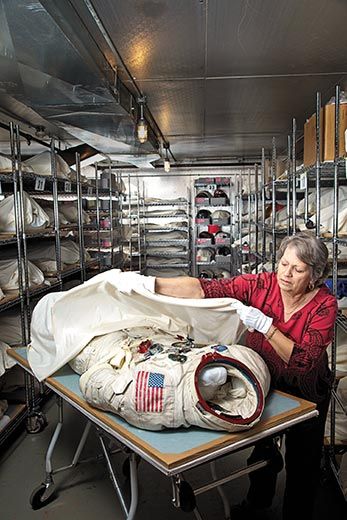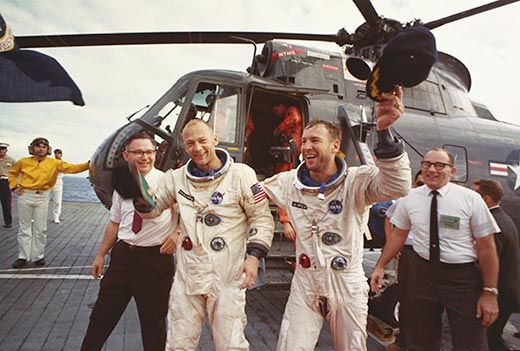After Space, Saving Suits, Boots and Gloves
The spacesuits that kept U.S. astronauts alive now owe their survival to one woman
/https://tf-cmsv2-smithsonianmag-media.s3.amazonaws.com/filer/Buzz-Aldrin-Jim-Lovell-spacesuits-631.jpg)
"Jack is the most beautiful. I just adore Jack," says Amanda Young, 62, eyeing a wall of photographs. She is perched on a short stepladder in her workshop at the National Air and Space Museum's Paul E. Garber Facility in Suitland, Maryland. "Gene is gorgeous," she adds. "Mike has knee problems."
Each image is of a different spacesuit. "Jack" is the suit once worn by geologist Harrison "Jack" Schmitt of Apollo 17; "Gene" is Eugene Cernan's suit; he commanded Apollo 17, which was the Apollo program's sixth and final lunar landing mission. "Mike" was worn by Michael Collins, who piloted the command module of Apollo 11, the mission on which Neil Armstrong took "one small step."
Young spends her days cleaning and preserving spacesuits. Some of the 220 garments under her care were worn for only one mission, after which NASA used them either for training other astronauts or sent them to the Smithsonian Institution. Others are never-worn prototypes.
"Jim," a cream-colored number once worn by Jim Lovell of Gemini 12—America's 16th manned spaceflight—lay on a table below the wall of photographs, and next to it was a rack with boxes containing astronaut gloves and helmets.
Young motioned to some boots. Age had caused them to shrivel and harden. The suits had been built to resist the extreme conditions of space travel "for a short period," Young says, "but it turns out they can resist nothing for a long period of time." When Young took over the collection in 1995, no one knew much about spacesuit preservation, including Young. She had started out as a secretary at the museum in 1985, taking on more and more responsibilities, which included lending spacesuits to other museums. Since becoming the collection's official caretaker, she has reached out to specialists in metals, plastics and rubber. Many of the suits' inner latex liners were crumbling to pieces. But experts helped her determine the optimal environment for the suits—68 degrees Fahrenheit and 35 percent relative humidity—to prevent decay. She also made her own discoveries. As the synthetic materials in the suit deteriorate, they release hydrochloric acid. Young learned that draping the suits in muslin absorbs much of it.
Young led me to a climate-controlled storage room surrounded by dusty aircraft and engines on the hangar's main floor. Inside, some 150 stuffed spacesuits (another 70 are on display at various museums) lay on their backs, five to a cart. Young rolled out "Neil," which wore a faded American flag stitched to its shoulder and a patch that read "ARMSTRONG"—the first suit to walk on the moon.
In an "ABC Evening News" piece that aired in 2002, Young was seen turning off the vault's lights and saying, "Goodnight, boys!" She was embarrassed by the sound bite but is not ashamed of her devotion to the suits. "My interest is in caring for these objects," says Young. "She's contributed quite a bit," says Bill Ayrey of ILC Dover, maker of the Apollo spacesuits, "because she's preserved these suits for the next generations to see and understand." Young wrote a book about the garments, Spacesuits, which comes out in June.
/https://tf-cmsv2-smithsonianmag-media.s3.amazonaws.com/accounts/headshot/megan.png)


/https://tf-cmsv2-smithsonianmag-media.s3.amazonaws.com/accounts/headshot/megan.png)